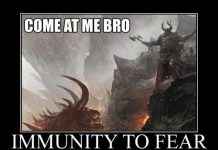LARP is short for “live action roleplaying” and in the past few years in the United States, it has started to gain more attention and popularity, although this enjoys wide popularity in Europe. Imagine that instead of being around a table narrating your adventure and rolling dice around a table, that you are physically dressed up in armor, have a foam sword in hand, and you can defeat a horde of attacking goblins to save a group of villagers. OR you can be defeated, kidnapped by these same goblins and trapped in a dungeon and have to figure out how to escape. That is just one scenario among many that you can participate in depending on the LARP you join.
While LARP seems like a strange concept to many, many of us are familiar with the idea of “playing pretend” or playacting when we are younger, but many of us end to believe that we give up this aspect of ourselves when we are older. However, there are a lot of contributing factors in contemporary culture that have led to LARPs growing popularity, like escape rooms, immersive theme parks like Hogwarts at Universal Studios, virtual worlds and even
You are generally going to come across five different types of LARPs:
Boffer LARP
This is often the picture that many people think of when they think “LARP” where people go out into a forest and use foam “boffer” swords (this is where the term “boffer LARP” comes from) and bean bags to represent spells or ranged attacks. Several pictures exist showing armed conflict.
These usually involve:
- Being in an outside space like a park or a camp or a wide space like a warehouse if this happens to be indoors.
- Extensive rules on physical contact and a system based on either losing hit points (like in a D&D or video game) or use of limbs.
- More uses of props and physical representations of items. At minimum,
larp -appropriate weapons - Various levels of physical activity, the minimum level is being able to move around the site. Some boffer LARPs are classified as light, medium and heavy to indicate the level of physical impact that is allowed in the LARP.
Examples of this kind of LARP include Twin Mask and Dystopia Rising
Parlor LARP
Parlor LARPs focus primarily on social interaction with gameplay. Contested challenges are resolved by comparing traits or mechanics like rock-paper-scissors to determine who wins a challenge in a conflict.
These usually involve:
- Being in an inside space or a more localized outside location. This type is often played in a house, at a club, or even at a convention. Setting or circumstances can be narrated by a storyteller to explain scenes that are happening (for example: “14 cops arrive at your house” without producing the cops)
- These usually involve fewer props. At
minimum , you need a character sheet with a set of skills - All physical combat is done by narration, no physical combat is supported by this system. This is the most accessible of all the LARPs
You can find several examples of this LARP at a gaming convention like KublaCon or Midwinter.
Quest LARP
Quest LARPs usually involve a starting point where you receive an adventure, moving through different spaces and performing a series of activities successfully, cumulating to an endpoint that finishes the game.
These usually involve:
- A starting point and an end point, while solving a series of puzzles or completing a set of activities
- Immersion varies on the LARP but most LARPs of this kind tend to have characters and sites that are engaged in the world setting as part of the experience
- Players may or may not be immersed personally
- Escape rooms that have an emphasis on LARP fall into this category
Examples of this kind of LARP are like RenQuest at the Renaissance Faire
Nordic LARP
Nordic LARP is a straight immersion of interaction, where the emphasis is on realism. Everything is represented as realistically as possible and not narrated. In some LARPs, if you as a person, cannot perform the skill like climb a tree, neither can your character. Nordic refers to the origin of this style of LARP rather qualified to be in Europe.
These usually involve:
- Being in an immersive environment and strict standards to keep everything in
genre to keep the world immersive. Usually, the setting is already pre-built, like a permanent Renaissance Faire structure, a set decorated to provide a realistic looking world or even an actual castle. - Costumes and props are part of the environment.
- More roleplay intensive and if there is combat, this would be actual combat with guidelines but most LARPs of this type do not have physical combat.
Examples: College of Wizardry,
Bespoke LARP
Bespoke LARP is a more recent form of roleplay where no action is allowed to happen to your character without your input and consent. Instead of creating a stalemate environment where no one concedes to each other in the effort “to win”, this pushes the players to highly dramatic roleplay because they are co-narrating scenes together.
These usually involve:
- Players negotiating conflict before the scene happens and once agreed, they perform the scene. This conflict can be social or physical, even if it includes weapons.
- Costumes and setting can be either representative or immersive; the players create most of the action
- Usually, the game is run as a one-shot LARP rather than a continuous chronicle
- Extremely roleplay heavy. Less emphasis on combat and more on theatrical and dramatic scenes.
Examples of this kind of LARP are the event: Convention of Thorns and The Night in Question
(Note: There are times when Nordic and Bespoke are considered similar to some groups; CoT and TNiQ were classified as Bespoke because this term was used specifically in their documentation.)
So here’s a big question: How do you join a LARP?
You can easily start by typing “LARP” in a search engine and looking at the closest major city or region in your area.
Another place where you can search for LARPs is Facebook where many LARPs have set up Facebook groups and pages for basic information about their games. Another source is going to be Instagram, where many of these LARPs are captured in photos and you can find several of them by entering #larp in the search. This will also give you great costuming ideas as well!
When not online, some places advertise their LARP in a local game store, but the biggest place to get to know a LARP is at a gaming or geek convention that has a LARP running in that venue. This is often an easy place to try a LARP or two to get a feel for the interaction and the game.
If you want to know







